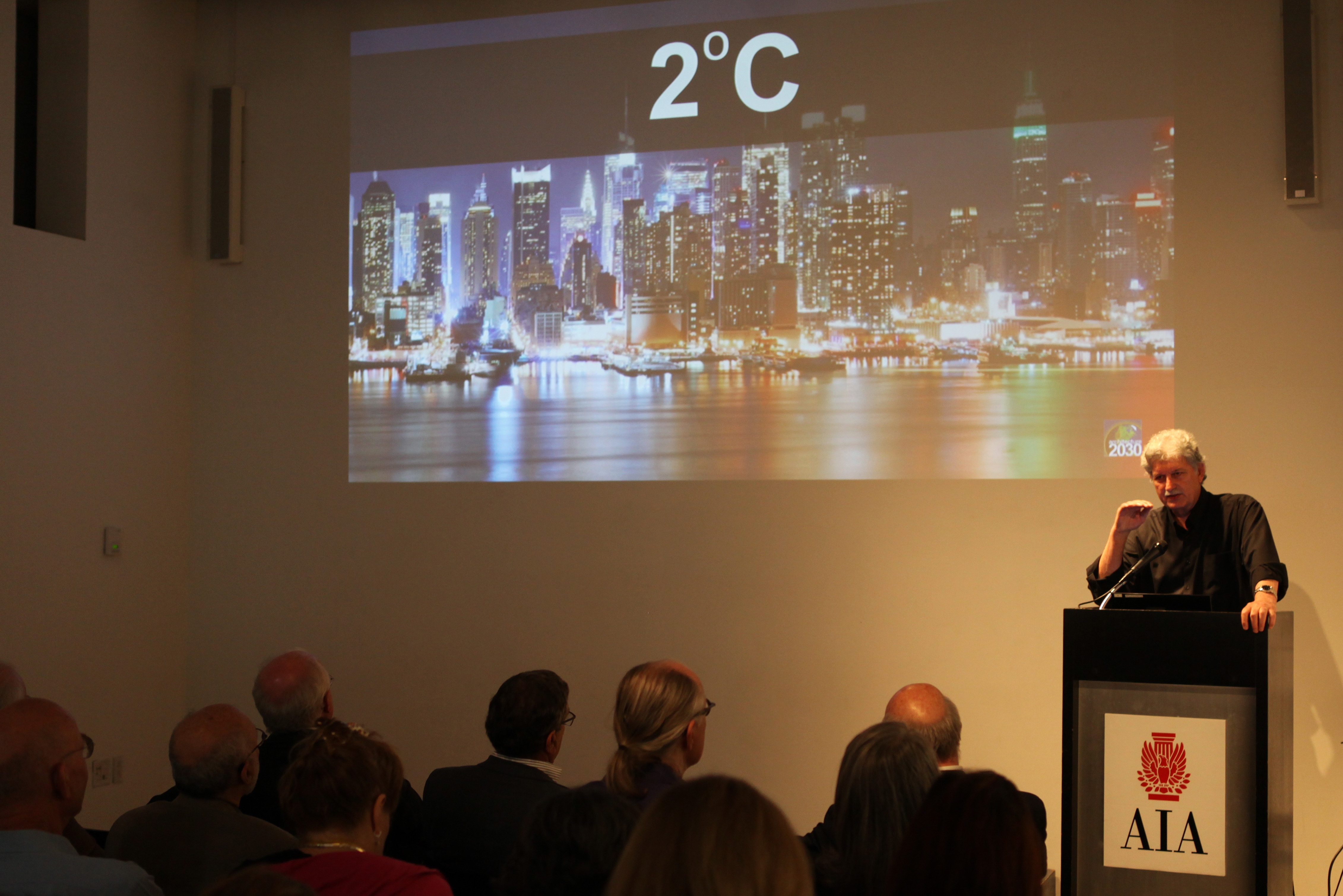by: Camila Schaulson Frenz
AIANY 2014 President Lance Jay Brown, FAIA, remembers how, at a 2007 centennial conference at the University of Michigan, Architecture 2030 founder and CEO Ed Mazria, AIA, concluded his presentation on the architect’s role in creating a carbon-free environment by projecting a full-screen headshot of his very beautiful granddaughter: “As I recall, he somewhat tearfully related his concern for her future based on our environment.” Seven years later, and following on the heels of the UN Climate Summit, the People’s Climate March, and Mayor Bill de Blasio’s climate-conscious announcement, Mazria’s outlook seems more optimistic. On 09.24.14, after reiterating the architecture and design community’s critical role in securing a livable future, he outlined the progress made in the building sector since issuing the 2030 Challenge.
The data is harrowing enough to make a pessimist out of anyone. Mazria reminded the audience that, according to the scientific community, an increase above the 2°C global average threshold would result in catastrophic, irreversible climate change. If we continue with business as usual, greenhouse emissions will escalate steadily, and temperatures will rise to levels with no recorded precedents: “By 2050, the Earth’s coldest years will be warmer than the warmest years we’ve ever experienced.”
But why are architects and designers so important to reversing climate change? To illustrate this point, Mazria gave the audience a crash-course in the History of Modernism. He detailed the unhealthy and unsafe state of our cities in the late 19th century, and how the modernist movement, in particular the International Congress of Modern Architecture (CIAM), set an agenda for social reform through the built environment. The guiding principles outlined by the CIAM congress – function-based zoning, efficient circulation, high-rise housing blocks set in abundant parkland – changed the way architects planned and designed the built environment, thus changing the social conditions of the city. According to Mazria, architects, and the world at large, are in need of a similar movement: “Today we have different issues that we need to address. We know what those issues are…We need a paradigm shift in how to design and plan.”
We now know that our built environment is also responsible for a large piece of the carbon emissions pie. In fact, it was moderator Susan Szenasy’s October 2003 issue of Metropolis magazine, “Architects Pollute,” that first caught the architecture community’s attention. “I must say that a lot of you were incredibly angry at that time,” Szenasy admitted. “We accused you of polluting. Of course, we all pollute, but architects pollute big time.” For example, buildings in New York City, for example, account for 75% of the city’s carbon emissions. Today, architects and planners also have a huge opportunity to solve this issue. According to Mazria, by 2030, 900 billion square feet of our built environment, the equivalent of 60% of the world’s entire building stock, will be rebuilt in cities worldwide. If we don’t act now, our energy and emissions patterns will be locked in for 80 to 120 years.
After rallying the architects in the crowd, Mazria listed the many ways in which the field has progressed since 2006. The 2030 Challenge has been signed by all major professional organizations, by 70% of the top 20 A/E multinationals and 52% of U.S. A/E firms, and by the federal government. Many states, counties, and cities have also adopted the targets, and building materials companies have pledged to reduce their own emissions by 50% by 2030. Sefaira has developed apps for SketchUp and Revit, allowing designers to see what every line in their design means in terms of consumption and emissions. The result is that every year after 2005, projections for building operations emissions have come down, saving U.S. consumers $560 billion in energy consumption. Mazria’s challenge has also gone global. At the International Union of Architects (UIA) Congress in Durban this summer, the 2050 imperative was unanimously signed, representing the support of 1.3 million architects in 124 countries.
We have signed onto the reduction targets, but what are our action items? If we are due for a paradigm shift, what exactly are our new guiding principles? Mazria and his team recently developed the 2030 Palette, a robust (but as yet incomplete) platform with 55 strategies, covering large-scale regional issues, buildings, and building elements applied to different locations worldwide. Most importantly, new approaches developed by architects can be added to the platform. Starting last week, the 2030 Palette launched templates, allowing all architects to create their own action items and share them with their global community.
Improvements are on their way, but as Szenasy noted during the Q&A, there is still more to do. How do architects account for the human factor, making sure that occupants do what is necessary to decrease energy use in their buildings? How can we make academia commit whole-heartedly to the challenge? Nonetheless, Mazria remains hopeful: “What I heard throughout my professional career from the architecture community is that our status as a profession was continually dropping. Lawyers get more respect; physicians get more respect. One time, during the Renaissance, we were it. Now, we get to solve, the world’s – mankind’s – greatest problem. This has been laid at our feet, to pick up that challenge and get the job done. We jump from the bottom of the food chain to the absolute highest point in the food chain. It cannot be done without us.”
Couldn’t make it to the talk? Watch it now on the Center for Architecture’s Vimeo page.
Event: DESIGN! Life Depends on Us
Location: Center for Architecture, 09.24.14
Speakers: Ed Mazria, AIA, Hon. FRAIC, Founder and CEO, Architecture 2030; Susan S. Szenasy, Hon. AIANY, Editor-in-Chief and Publisher, Metropolis magazine; and Lance Jay Brown, FAIA, 2014 President, AIANY (introduction)
Organizers: Center for Architecture
Sponsors: Architecture 2030
Co-sponsors: AIANY Committee on the Environment (COTE) and AIANY Design for Risk and Reconstruction Committee (DfRR)











